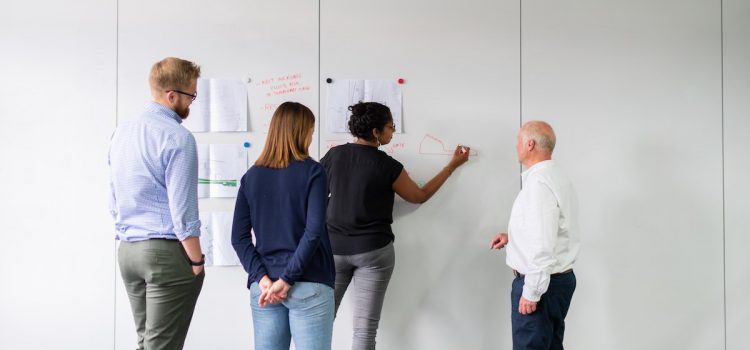

This article is an excerpt from the Shortform book guide to "The Fifth Discipline" by Peter M. Senge. Shortform has the world's best summaries and analyses of books you should be reading.
Like this article? Sign up for a free trial here.
What is “team learning” in Peter Senge’s The Fifth Discipline? Why is it important to create opportunities for your employees to learn together?
Team learning is the fourth discipline in Peter Senge’s framework for creating a learning organization. Team learning encourages people to find ways to work together effectively despite the differences in personalities and communication styles.
Here’s how you can implement the discipline of team learning in your organization.
What Is Team Learning?
According to Peter Senge, team learning is the process by which a group of people learns how to work together effectively and help each other reach their shared goals. Senge says that team learning has three key aspects:
1) Group-based worldview improvement. Team members should work together to identify each other’s faulty assumptions and improve each other’s worldviews.
2) Spontaneous teamwork. A team that has learned to work together and evolve together will sometimes take actions that are unplanned, yet perfectly coordinated. Much like a trained and practiced troupe of improvisational actors, the team members understand and trust each other to the point that their teamwork becomes instinctual.
| Shared Consciousness and Individual Empowerment In Team of Teams, retired US Army general Stanley McChrystal also discusses this sort of spontaneous teamwork, which he calls shared consciousness. McChrystal describes this phenomenon as a moment when people stop thinking as individuals and instead become a single cohesive unit. As an example, he talks about three Navy SEAL snipers who—having built this kind of instinctive teamwork through intense training and experience—acted together without communicating to take down three different targets simultaneously. McChrystal adds that spontaneous teamwork requires team members to be empowered, meaning each person is able to act on his or her own without needing to consult a superior. In his anecdote, the three snipers didn’t need to wait for a command to fire—they all simply knew when the moment was right and took the opportunity. In fact, needing to get approval from a higher-up would have interrupted their seamless teamwork and made them less effective—they could have missed their opening while waiting for the go-ahead. In short, spontaneous teamwork happens when people have the authority to act independently and the experience to act synchronously. |
3) Connections with other teams. Remember that your team is just one part of a larger system, and whatever decisions you make will likely need other teams from other parts of the organization to put them into practice. Therefore, it will benefit your team (and the organization as a whole) to promote team learning practices among those other teams as well.
Senge warns that team learning is a difficult process, and it will take a lot of practice—figuring out how to work together effectively often means discovering all the ways that you don’t work together effectively. Personalities might clash, ideas may interfere with each other, and team members might find themselves stepping on each others’ toes when communication isn’t clear enough. That’s why Senge lays down the rule: Do not assign blame.
An evolving team—and an evolving organization—is bound to make mistakes along the way. In fact, that’s how evolution happens: People make mistakes or run into problems and then learn how to avoid them in the future. Just remember that you are a team, working together and learning together. So, instead of turning against each other to find someone to blame, turn your combined efforts against the problem.
How Team Learning Ties Into the Big Picture
According to Peter Senge, team learning is, in essence, organizational evolution on a smaller scale. It requires the same skills and practices as improving your organization’s worldview, and it’s how your team members help each other to accomplish the organization’s common mission.
Also, your team is part of the organization as a whole—so by helping your team to improve its worldview, develop teamwork, and spread those skills to other teams, you’re directly doing the work of creating an evolving organization.
Remember that an organization is nothing but the people who comprise it—once every team and every person in the organization is practicing personal growth and big-picture thinking, you will have created an evolving organization.
| How to Lead Organizational Change Successfully creating any kind of organizational change, either on a team level or a whole-organization level, is difficult; it requires strong leadership, a clear vision, and collective effort from members of the organization. Leadership expert and consultant John Kotter writes in Leading Change that effective organizational change is a seven-step process: 1. Create urgency. Make sure everyone understands why this change has to happen and why it has to happen now. 2. Make a team. Put together a group of people with diverse skill sets to lead the organizational change. 3. Develop your vision. Make sure you have a clear and specific idea of your company’s future. In other words, what are you ultimately trying to accomplish by making this change? 4. Sell your vision. Prepare a statement that you can distribute through the organization explaining what your vision is and why it’s right for the company. Make sure your statement is clear—avoid jargon—and invite feedback on and discussion about the vision. 5. Clear the way. Identify obstacles to change and overcome them. Common obstacles include pushback from supervisors and managers and insufficient training among core staff. 6. Set small goals to produce small victories. As you implement large-scale and long-term change, keep people motivated and determined by setting achievable milestones and celebrating when you pass them. 7. Update the company culture. Once you’ve accomplished your change, make it stick by making it a part of the company culture. For example, if your goal was to boost employee satisfaction, you might try relaxing the company dress code or guaranteeing more vacation time in employee contracts. Make sure your organizational leaders are on board with the new culture—you might find it necessary to replace the most recalcitrant supervisors or managers. |

———End of Preview———
Like what you just read? Read the rest of the world's best book summary and analysis of Peter M. Senge's "The Fifth Discipline" at Shortform.
Here's what you'll find in our full The Fifth Discipline summary:
- Why an organization should encourage its members to constantly learn and develop their skills
- The five disciplines for creating an evolving organization
- Why you should constantly assess and update what you think you know






